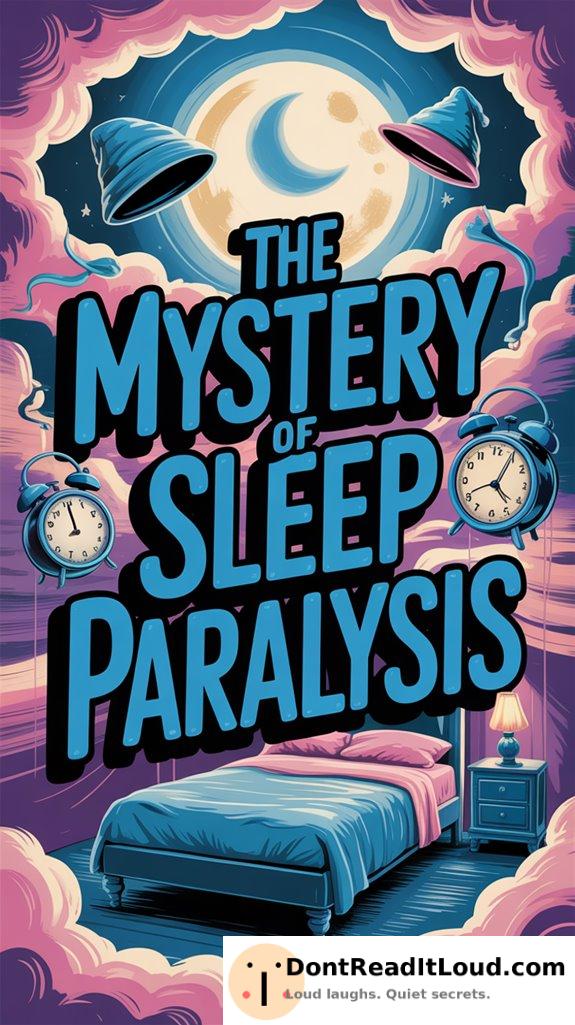
Sleep paralysis is that eerie state where your mind wakes up, but your body doesn’t get the memo. It occurs during transitions between sleep and wakefulness and is often marked by vivid hallucinations, such as shifting objects or shadowy figures. Though once blamed on demons or spirits, sleep paralysis is actually a natural response connected to REM sleep. Triggers include lack of sleep and frequent nightmares. Much about this mysterious phenomenon remains unknown.
Understanding Sleep Paralysis: The Science Behind the Phenomenon
Although often unsettling, sleep paralysis is a natural phenomenon that occurs during the shift between sleep and wakefulness. Imagine you’re caught between a dream about flying sandwiches and the jolt of your alarm clock.
Sometimes, bits of your dream can spill into reality, leaving you with lingering nightmares. During REM sleep, your mind is active, but your muscles remain temporarily paralyzed.
While your brain feels alert, your body stays still, creating a confusing disconnect. There’s no need to worry—this isn’t the work of restless spirits. It’s just your body’s unusual way of moving between sleep and wakefulness, sometimes with oddly comic timing.
Common Triggers and Risk Factors of Sleep Paralysis
Experiencing sleep paralysis can be unsettling, but understanding what might trigger it can help you manage the phenomenon. Let’s clear this up: sleep paralysis isn’t just a scary story, though it can certainly feel that way.
One major cause is sleep deprivation. Staying up late to binge-watch shows doesn’t just make you tired—it can also increase your chances of experiencing these episodes.
Nightmares can also play a role. If your dreams are filled with horror, consider changing your bedtime routine to something calming. A relaxing evening ritual can help protect you from unsettling sleep experiences.
Hallucinations and Sensory Experiences During Sleep Paralysis
During sleep paralysis, the mind can play tricks, leading to vivid hallucinations and intense sensory experiences. Imagine lying there, unable to move, as your favorite childhood teddy bear transforms into a menacing monster. Nightmare hallucinations like these are common. Your brain seems eager to liven up this unsettling moment.
At the same time, unusual sensations can occur. You might feel as if you’re sinking into your mattress or floating above it. The walls may seem to close in, turning your familiar bedroom into a scene from a horror film. While it’s hardly a thrill ride you’d choose, you do get a front-row seat to your mind’s bizarre performance. Enjoy the show!
Cultural and Historical Perspectives on Sleep Paralysis
Throughout history and across cultures, sleep paralysis has been shrouded in mystery and intrigue. Tales abound: from ancient beliefs of demons sitting on chests to cultural interpretations involving mischievous spirits.
It seems every society found its own way to make sleep paralysis frightening. The Ancient Greeks blamed the god Pan, while in Japan, evil spirits were thought responsible. Scandinavians believed troublesome elves were the ones holding people down. You’d think those elves might’ve better things to do.
In today’s pop culture, sleep paralysis often features in horror movies. So, if you wake up unable to move, remember you share this experience with countless others throughout history. Sweet dreams!
Conclusion
You’ve now grasped the complexities of sleep paralysis, uncovering the science, triggers, and vivid hallucinations tied to this phenomenon. By understanding these elements, you can better identify potential risk factors and perhaps ease anxieties when faced with such experiences. Sleep paralysis has appeared in stories and beliefs around the world, reflecting its universal fascination. Staying informed can help you feel more prepared if you experience these strange episodes. Rest easy, knowing knowledge is your ally.



